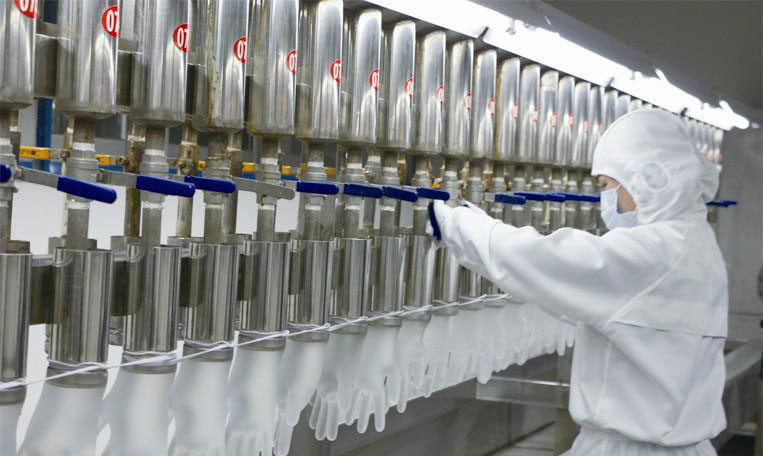Contact: Manager Zhang
Telephone: 13115255999
Fixed line: 86 0517-84746999
Fax: 86 0517-84743098
Address: 200 meters south of Hongqiao, West of Old Huaisi Road, Yugou Town, Huaiyin District, Huai'an City
Website: www.hagcgm.com
Technical development level analysis
Disposable nitrile gloves are a kind of chemical synthetic material, made of acrylonitrile and butadiene through a special process and formula improvement, the air permeability and comfort are close to latex gloves, and will not cause any skin allergies. Nitrile gloves have been developed in recent years. During production, after cleaning, they can reach 100 or 1000 grades. Most disposable nitrile gloves are powder-free.
1. The source of nitrile rubber
Butyronitrile is formed by emulsion polymerization of butadiene and acrylonitrile. In order to improve the bonding strength and physical and mechanical properties of wet gel and vulcanizate, most nitrile latexes are modified by introducing third-party monomers such as carboxyl groups during copolymerization. Commonly used carboxyl monomers include acrylic acid and methacrylic acid. Carboxylated nitrile latex can significantly improve the mechanical stability, oil resistance and aging resistance of the latex.
2. Production process
Hand mould cleaning → hand mould oven → coagulant tank → oven → latex tank 1 → oven → latex tank 2 → oven → washing → oven → crimping → main oven → cooling → chlorine washing tank → washing → neutralization → washing → PU Slot → final oven → pre-release → demolding → inspection → packaging → storage → outgoing inspection → packing and shipping.
Technology innovation trend analysis
The production technology of nitrile gloves has been updated rapidly in recent years. The new production technology represented by the unilateral two-hand touch process has greatly improved the production efficiency, and also gave new entrants a clear advantage in latecomer. At the same time, because the investment cost of the nitrile glove production line is higher than that of PVC gloves, and there are fewer professional practitioners, the capital and technical threshold of the nitrile glove industry is relatively high.
There are also grades in nitrile gloves, including nitrile examination gloves and nitrile gloves as surgical gloves, as well as nitrile used in industry (such as the auto repair industry). It is an organic chemical synthetic material. Using acrylonitrile and butadiene as raw materials, it is made through special process treatment and dosage improvement. Not only is the breathability and comfort close to latex gloves, but the performance of all gloves is the closest to latex gloves. Better than latex gloves is that there are no other allergic skin conditions. Nitrile gloves are mostly powder-free gloves, which have developed rapidly in recent years. At this stage, they have been recognized by the market, and sales are increasing day by day.

Next, the Huaian nitrile glove manufacturer will introduce its advantages, let’s take a look!
1. Good chemical resistance, acid and alkali resistance, and good chemical protection against corrosion-resistant substances such as solvents and oils.
2. Good physical properties, tear resistance, puncture resistance, and abrasion resistance.
3. Comfortable materials, the glove machine is designed according to ergonomics, making it comfortable to wear and conducive to blood circulation.
4. It does not contain harmful substances such as protein and amino acids, and rarely causes skin allergies.
5. Fast degradation rate, convenient handling and environmental protection.
6. It does not contain silicon and has a certain antistatic function, which is more suitable for electronic manufacturing.
7. There are few chemical residues on the surface, low ion content, small particle content, suitable for strict clean room environment.
Nitrile gloves are more suitable for homework, electronics, organic chemicals, aquaculture, glass separation, food and other industries for factory protection, hospitals, scientific research and other industries for safe use; widely used in the semiconductor industry, precision electronic components and instruments, adhesive metals Installation and operation of containers, installation and debugging of high-tech products, disk drives, composite materials, liquid crystal displays, circuit board production lines, optical products, laboratories, hospitals, beauty salons and other fields.